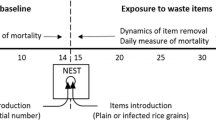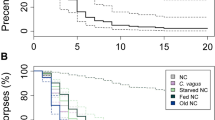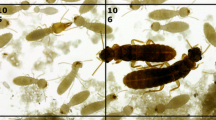Summary
Most of the duties in an incipient colony of the fungus-growing termiteMacrotermes michaelseni (Sjöstedt) are perfomed by the workers. While foraging was observed only in major workers, all of the other elements were seen in both major and minor workers. The behavioural elements were grouped as follows: (I) Alarm behaviour, shown by shaking of the whole body; (II) Building behaviour, including palpation of the inner surface of the nest, picking up of a piece of soil, transport of the soil, and deposition of the soil; (III) Procurement of food by foraging, chewing and swallowing of hay pieces, deposition of semi-liquid faecal pellets on the fungus comb, claning of the fungus comb and the fungus nodules, and feeding from fungus nodules and old fungus comb; (IV) Moisture regulation either by water intake with the hypopharynx or water release through the mouth cavity; and (V) Interindividual behaviour, consisting of cleaning all the termite castes as well as the larvæ, cleaning and moistening the eggs, feeding reproductives and larvæ with a liquid and soldiers with fungus comb material, liquid transfer between workers, faecal intake from the larvae, facilitation of hatching and moulting of the larvae.
Reproductives showed alarm, building and grooming behaviour as well as moisture regulation only before the workers emerged in the incipient colony. The minor soldiers showed alarm and defensive behaviour but the only recorded behaviour of the larvæ was shaking of the body.
Zusammenfassung
Die meisten Aufgaben in der jungen, pilzzüchtenden Termitenkolonie der ArtMacrotermes michaelseni werden von den Arbeitern ausegeführt. Beim Futtereinbringen wurden nur grosse Arbeiter beobachtet, alle andern Verhaltenselemente wurden sowohl von kleinen als auch von grossen Arbeitern gezeigt. Die Verhaltenselemente der Arbeiter wurden in folgende Gruppen unterteilt: 1. Alarmverhalten mittels Schütteln des ganzen Körpers; 2. Bauverhalten, bestehend aus den Elementen Bepalpern der innern Nestoberfläche, Aufnahme eines Erdstückes, Transport der Erde und Deponieren derselben; 3. Nahrungsbeschaffung durch Futtereinbringen. Kauen und Schlucken von Heustücken, Ablagerung halbflüssiger Fäkalienkügelchen auf den Pilzgarten, Reinigung des Pilzgartens und der Pilzkörperchen, sowie Fressen von Pilzkörperchen und altem Pilzgarten; 4. Feuchtigkeitsregulation entweder durch Wasseraufnahme mit dem Hypopharynx oder Wasserabgabe durch die Mundhöhle; 5. Interindividualverhalten, bestehend aus den Elementen Putzen aller Termitenkasten sowie der Larven, Putzen und Befeuchten der Eier, Füttern der Geschlechtstiere und Larven mit einer Flüssigkeit resp. der Soldaten mit Pilzgartenmaterial, Flüssigkeitsaustausch zwischen Arbeitern, Fäkalienaufnahme von den Larven, Häutungshilfe an Larven und beim Schlüpfen der Eilarven.
Die Geschlechtstiere zeigten Alarm-, Bau- und Individualverhalten sowie Feuchtigkeits-regulation gleich wie die Arbeiter bevor diese in den jungen Kolonien erschienen. Die kleinen Soldaten zeigten Alarm- und Abwehrverhalten, während als einzige erwähnenswerte verhaltensform der Larven Schütteln des Körpers aufgenommen wurde.
Similar content being viewed by others
References
Abo-Khatwa N., 1978. — Cellulase of fungus-growing termites: A new hypothesis on its origin.Experientia, 34, 559–560.
Eisner T., Kriston I., Aneshansley D.J., 1976. — Defensive behavior of a termite (Nasutitermes exitiosus).Behav. Ecol. Sociobiol., 1, 83–125.
Farhat A., Iqbal Q.J., 1976. — Mating behaviour of termiteMicrocerotermes heimi (Isoptera: Termitidæ).Pakistan J. Zool., 8, 229–230.
Grasse P.P., 1939. — La reconstruction du nid et le travail collectif chez les termites supérieurs.J. Psychol., 370–396.
Grasse P.P., 1978. — Sur la véritable nature et le rôle des meules à Champignons construites par les Termites Macrotermitinae (Isoptera Termitidae).C. R. Acad. Sc., 287 (D), 1223–1226.
Howse P.E., 1965. — On the significance of certain oscillatory movements of termites.Insectes Soc., 12, 335–346.
Howse P.E., 1966. — Air movement and termite behaviour.Nature, 210, 967–968.
Leuthold R.H., 1977. — Postflight communication in two termite species,Trinervitermes bettonianus andHodotermes mossambicus. Proc. 8th Congr. IUSSI, Wageningen, 62–64.
Leuthold R.H., Bruinsma O., 1977. — Pairing behavior inHodotermes mossambicus (Isoptera).Psyche, 84, 109–119.
Lüscher M., 1951. — Significance of “Fungus Gardens” in Termite Nests.Nature, 167, 34–36.
Lüscher M., 1961. — Air-conditioned Termite Nests.Sc. Am., 205, 138–145.
Martin M.M., Martin, J.S., 1978. — Cellulose digestion in the midgut of the fungus-growing termiteMacrotermes natalensis: the role of acquired digestive enzymes.Science, 199, 1453–1455.
McMahan E.A., 1974. — Non-aggressive behavior in the large soldier ofNasutitermes exitiosus (Hill) (Isoptera: Termitidae).Isectes Soc., 21, 95–106.
Nel J.J.C., Hewitt P.H., Smith L.J., Smit W.T., 1969. — The behaviour of the harvester termite (Hodotermes mossambicus) (Hagen) in a laboratory colony.I. Entomol. Soc. Sth. Afr., 32, 9–24.
Noirot P.C., 1952. — Les soins et l'alimentation des jeunes chez les termites.Ann. Sc. Nat. Zool., 14, 405–414.
Nutting W.L., Blum M.S., Fales H.M., 1974. — Behavior of the North American termiteTenuirostritermes tenuirostris, with special reference to the soldier frontal gland secretion, its chemical composition, and use in defense.Psyche, 81, 167–177.
Roonwal M.L., Rathore N.S., 1975. — Swarming, egg-laying and hatching in the Indian desert harvester termite,Anacanthotermes macrocephalus (Hodotermitidae),Ann. Arid. Z., 14, 329–338.
Sands W.A., 1960. — The initiation of fungus comb construction in laboratory colonies ofAncistrotermes guineensis (Silvestri).Insectes Soc., 7, 251–259.
Sands W.A., 1961. — Foraging behaviour and feeding habits in five species ofTrinervitermes in West Africa.Entomol. Exp. Appl., 4, 277–288.
Stuart A.M., 1969. — Social behavior and communication. In “Biology of termites”, ed. K. Krishna and F. Weesner, I. Academic Press, New York.
Watson J.A.L., Nel J.J.C., Hewitt P.H., 1971. — The uptake of water by eggs of the termiteHodotermes mossambicus (Hagen) (Isoptera).Insectes Soc., 18, 233–242.
Author information
Authors and Affiliations
Rights and permissions
About this article
Cite this article
Sieber, R., Leuthold, R.H. Behavioural elements and their meaning in incipient laboratory colonies of the fungus-growing TermiteMacrotermes michaelseni (Isoptera: Macrotermitinae). Ins. Soc 28, 371–382 (1981). https://doi.org/10.1007/BF02224194
Received:
Accepted:
Issue Date:
DOI: https://doi.org/10.1007/BF02224194




